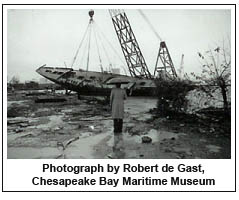|
The recreated schooner ATLANTIC
Profile of the entrepreneur Ed Kastelein
 From his mother’s side Dutchman Ed Kastelein (60) is a descendant of the founders of the Holland-America Line shipping company, while his father’s family were fishermen for centuries. Seafaring is his nature. Only twelve years old he built his first canoe from old barn planks and on his fourteenth he was sailing a 12m˛ Sharpie. Several Dutch BM-sloops followed and at the age of sixteen he was restoring sailing boats in his spare time.
From his mother’s side Dutchman Ed Kastelein (60) is a descendant of the founders of the Holland-America Line shipping company, while his father’s family were fishermen for centuries. Seafaring is his nature. Only twelve years old he built his first canoe from old barn planks and on his fourteenth he was sailing a 12m˛ Sharpie. Several Dutch BM-sloops followed and at the age of sixteen he was restoring sailing boats in his spare time.
He established a flourishing property development company focusing on high quality restaurants and café’s in the Rotterdam area. And some 30 years ago he chose to concentrate on sailing only. He bought the 16 meter wooden Colin Archer Gaff Ketch Zeeland, and chartered her for three years across the Mediterranean. He owned the Lunstroo designed 31 meter schooner Borkumriff, built for Baron William Von Fink in 1980. In 1987 he acquired the yawl Aile Blanche and subsequently he owned the maxi-racer Ondine and the 1936 Alfred Mylne designed Thendara, until the experience he had gained on and off the water made him
realize that building new was not necessarily more expensive than restoring.
Kastelein had fallen in love with the lines of Zaca, owned by actor Errol Flynn. The wooden yacht was lying in a far state of decomposition in the south of France and it seemed impossible to save her. He decided to commission a look-alike, the 38 meter Grand Banks schooner Zaca a te Moana, launched in 1992. Not only does he have an insatiable appetite for sleek classical lines, he also has a remarkable penchant for drama. The inspiration of the 42 meter Eleonora, launched in 2001, was the Nat Herreshoff designed Westward, which was not devoid of drama too. Under her last owner, Mr. T.B. Davis from Jersey, the schooner participated in almost all major races sailed after World War I, and won most. But having survived the second World War, funds were scarce and Mr. Davis’ will stipulated that Westward was to be scuttled in The Channel in case his heirs would not have the means to maintain her properly. And sadly thus it happened. On July 15th 1947 she was blown up by explosives and sank shortly after.
Of course the story of the ATLANTIC is the most famous. The 100 years old transatlantic regatta record for mono hulls, set by Charlie Barr and his crew in 1905 has made the yacht a myth. She certainly is one of the most loveliest and fastest yachts ever built and the gracile three masted silhouette is still on everybody’s retina.
Kastelein has managed the entire ambitious project solely. He has gathered copies of dozens of drawings of the original ATLANTIC from various archives in the USA. And he has studied hundreds of images of the original that have been saved. Unfortunately very little drawings of the interior have been preserved, but with the help of photographs Kastelein has been able to copy the colonial style and atmosphere which characterized the mother yacht. For the equipment like anchor, bollards, hawse-hoses, stanchions, belaying pins and even the ensign-pole support, Kastelein will draw on his extremely vast experience with Eleonora and have new casting patterns custom manufactured.
ATLANTIC is built for luxury charter purposes and as such she will participate in most classical boat races, like the famous Voiles de Saint Tropez. As the largest classical racing schooner ever rebuilt, she will generate waves of admiration wherever she sails. Kastelein has succeeded again to revive sailing history thanks to his life-long passion and his dedicated and experienced build team. When asked what drives him to undertake a challenge of this size the answer is: “Hoist and set sail as the yacht takes to the sea makes a dream come through”.
Brief history
 Commissioned by New York Yacht Club member Wilson Marshall, the ATLANTIC was built in 1903 by Townsend & Downey, Shooter Island, New York. William Gardner, one of America's foremost designers of the period 1890 -1930, designed her. Gardner designed boats and ships of most types and one of his staff was responsible for drawing the Star class, that developed into the international keel boat icon. From the moment ATLANTIC went to sea, it was clear that she was an exceptionally beautiful and fast schooner. When a yacht in 1903 hits twenty knots during her sea trials, she is a promising yacht. But nobody could imagine that two years later this yacht would set a record that would stand unmatched for a century.
Commissioned by New York Yacht Club member Wilson Marshall, the ATLANTIC was built in 1903 by Townsend & Downey, Shooter Island, New York. William Gardner, one of America's foremost designers of the period 1890 -1930, designed her. Gardner designed boats and ships of most types and one of his staff was responsible for drawing the Star class, that developed into the international keel boat icon. From the moment ATLANTIC went to sea, it was clear that she was an exceptionally beautiful and fast schooner. When a yacht in 1903 hits twenty knots during her sea trials, she is a promising yacht. But nobody could imagine that two years later this yacht would set a record that would stand unmatched for a century.
The gleaming raven black ATLANTIC measured 56.43 meters (185’) over the bows without bowsprit outboard of 8.76 meters (29’) and with her beam of 8.85 meters (29’) and draft of 5.50 meters (18’) her displacement was 395 tons. She could carry 2,000 m˛ (22,000 square feet) of canvass. During her first season ATLANTIC proved fast, winning both the longer races Brenton Reef and the Cape May Cup hands down. But she would just have been another graceful yacht of that departed era if she had not entered and won the transatlantic Kaiser’s Cup in 1905. That one voyage from New York to The Lizard established her place in history by setting a record of 12 days, 4 hours and one minute.
The owner Wilson Marshall was the heir to his father’s Broadway Stage Line fortune and a stickler for comfort. Grieved by the death of his wife in 1897, he commissioned ATLANTIC as a sanctuary where all the troubles could not catch up to him. Unlike contemporary racing schooners, ATLANTIC was equipped with every imaginable luxury. The schooner could do 17 knots on her steam engine of 400hp, weighing 30 tons including boiler, exclusive fuel. She had two steam driven generators powering up the electric lights and refrigerators and there was a large galley. On deck her halyard winches and primary sheet winches were steam driven too. She had two double and three single staterooms fitted out with the finest mahogany paneling. The lobby had marble flooring, there was a large full beam saloon, a dining room, a chart & gunroom, three large tiled bathrooms (with bath tubs) and in the deckhouse there was a comfortable observation room. She had retractable chimneys, so while under sail the below deck lighting, refrigerating and steam heating systems could keep running. The fo'c'sle accommodated her thirty-nine strong crew and officers, who would live aboard throughout the year.
Lem Miller, the right hand of Charlie Barr in all three America’s Cup victories, was appointed captain. But though he had won several ocean races with ATLANTIC, Marshall wanted a “name” skipper for the Kaiser’s Cup and he hired Miller’s friend and mentor Barr. After much preparatory work, amongst which the removal of the centerboard with a drop of 2.70 meters ATLANTIC had been designed with, lots of spare gear was taken on board for the crossing. But it was Barr's determination to win and his skills for driving the largest of yachts to the very limit that resulted in the record. Winning the Cup made Barr a fortune and he moves on to skipper Westward in 1910. In 1917 Wilson Marshall sold the yacht to the US Navy.
Amongst the later owners of ATLANTIC figure names of railway and coal magnate Cornelius Vanderbilt (1924-1928) and Gerald Lambert of the Lambert Pharmacal Cy, the inventor of Listerine (1929-1942). Lambert entered the yacht for the first transatlantic race since the one of 1905 from New York to Spain in 1928. Though, because of her record she was the favorite in the race, she had to acknowledge Elena’s superiority in the light reaching breezes that prevailed. Subsequently the schooner served as a mother ship for famous racing yachts like Vanity and the J-Class Yankee while racing in England. Her guest book included the rich and famous of the world. In World War II she was used by the coast guard on anti-submarine patrol. She was laid up for several years after the war and was then sold down the river. Stripped of her lead she sat in the mud of the New Jersey Intracoastal Waterway as a roadside tearoom and gift shop. Finally she was sold to the ship-breakers and was towed to the Delaware River to be scrapped. Her keel was removed, but before the hammers went to work on her hull, she was saved by a sentimental yachtsman named Bright, who had heard of her imminent fate. That was her last fling. Eventually her plates rusted through and she sank after her owner died in 1968. Finally in 1982 the wreck was salvaged and she got the decent burial she deserved, being cut up and hauled away at Newport Harbour, Virginia.
Technical details
Design |
GARDNER & COX, NY, 1903 |
Consulting naval architect | Doug Peterson, San Diego, 2006 |
Hull construction material | Steel |
Length overall | 69.24 m 227 ft |
Length of hull | 56.43 m 185’ |
Length of waterline | 41.18 m 135’ |
Beam | 8.85 m 29’ |
Draft | 5.00 m 16’ 5” |
Main mast above waterline | 44.00 m 144’ 5” |
Bowsprit outboard | 8.76 m 28’ 8” |
Mizzen boom outboard | 4.05 m 13’ 3” |
Displacement | 395 tons |
Ballast | 120 tons |
Sail area | 1,721 m˛ 18500 square ft |
Fuel tank capacity | 17,000 L |
Fresh water capacity | 5,000 L |
Waste water capacity | 12,000 L |
Service power | 24V/230V/400V |
Engine | Yanmar 6 AYM-ETE, 829 HP/610 kW |
Generators | Yanmar 6 CYL 100 kWe/1500 rpm
Yanmar 6 CYL 45 kWe/ 1500 rpm |
Bowthruster | Veth 75 kW |
Lower masts | Custom Nedal alloy extrusion |
Top masts | Custom formed alloy |
Gaffs, yards and poles | Brasker Masts, Alaskan Sitka Spruce |
Winch pack | Harken, all bronze, custom manufactured |
Windlass | Thomas Reed, classic model newly built |
Deck fittings | Absolute Projects, Lisbon |
Paint system | Awlgrip |
Air-conditioning | MAR-IX by Mavé, Holland |
Navigation system | Simrad |
Interior design | Ed and Sophie Kastelein |
Classification | Bureau Veritas for charter yachts |
Certification | MCA |
Builder | Ed Kastelein
Tel + 33 685 057 884
E-mail kastelein@wanadoo.fr |
ATLANTIC-FinalAccomodationsPlan (PDF, .22mb)
TOP
|